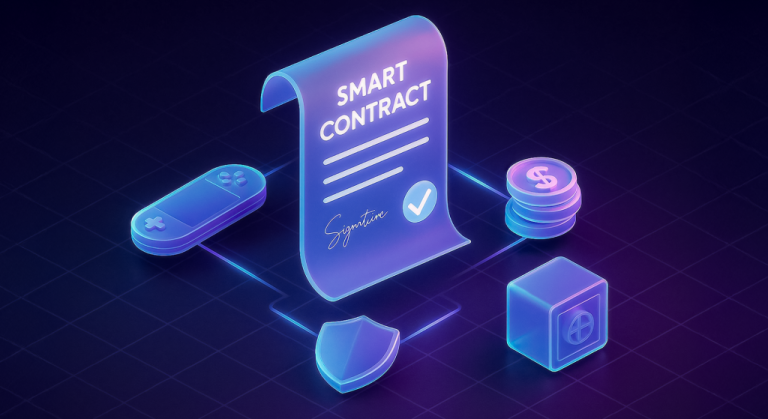In an era of deepfakes and rampant data breaches, businesses and consumers alike face a digital identity crisis. Hyper-realistic fake videos and synthetic identities can outsmart traditional verification, while centralized databases leak personal data by the billions. The solution? Blockchain AI digital identity systems combining the immutability of blockchain with the intelligence of AI to restore trust.
This article explores how blockchain and AI together enable identity verification, anti-deepfake defenses, and ownership proof for a safer digital world.
The Rise of Deepfakes and Weaknesses of Traditional Identity Systems
Deepfakes – AI-generated fake videos, images, or voices have exploded in prevalence and sophistication. Fraud attempts using deepfakes surged 2137% over the last three years, and nearly half of businesses reported being targeted by audio/video deepfake fraud in 2024. These forgeries enable impostors to bypass biometric checks and fool humans, leading to costly scams (average losses approaching $500,000 per incident) and eroding trust in digital interactions. Traditional identity verification methods are struggling to keep up, as deepfakes can mimic live faces or voices to slip through Know-Your-Customer (KYC) checks.
At the same time, legacy identity systems have long-standing weaknesses that undermine security and privacy:
- Centralized data silos: Personal data is stored in centralized databases (government ID systems, corporate servers), creating juicy targets for hackers. Breaches have exposed billions of identity records, fueling identity theft and fraud.
- Password-based authentication: Reliance on passwords and knowledge-based questions is error-prone. Passwords can be stolen or cracked, and reused credentials make it easy for attackers to takeover multiple accounts.
- Manual verification bottlenecks: Traditional ID checks (in-person document inspection, notarizations) are slow, costly, and prone to human error or forgery. Fake IDs or doctored documents can fool untrained eyes.
- Limited interoperability: Each service issues its own identity credentials (logins, IDs) that aren’t portable. Users juggle dozens of identities, increasing friction and chances of mishandling or exposure.
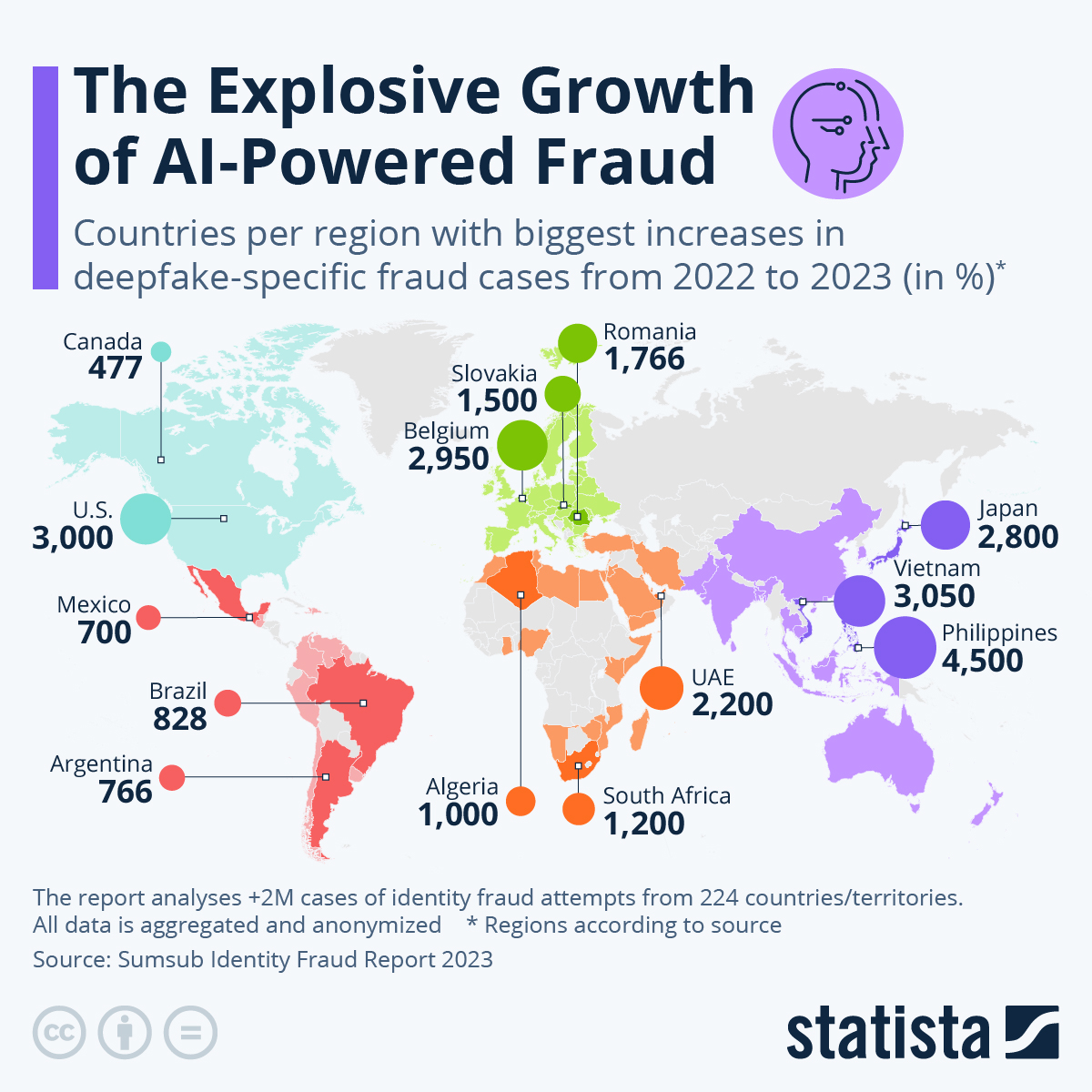
Global deepfake fraud surge – percentage increase by country (2022–2023). Highlights exponential growth in deepfake-related identity fraud across regions, illustrating how traditional identity systems are failing to keep pace. (Source: Statista “The Explosive Growth of AI-Powered Fraud” chart)
In short, today’s identity infrastructure wasn’t built for a world of AI-generated fakes and determined cybercriminals. New approaches are needed to verify authenticity and establish trust in digital identity.
Blockchain: Adding Data Integrity and Ownership Proof to Digital Identity
Blockchain technology offers a foundation of trust and data integrity that can fortify digital identity systems. A blockchain is a decentralized, tamper-evident ledger once data is recorded, it cannot be altered or deleted, creating a single source of truth. Here’s how blockchain addresses the identity challenges:
- Immutability and Integrity: Identity credentials (e.g. digital IDs, certificates) stored or referenced on a blockchain are secured by cryptography and consensus. No malicious actor can covertly manipulate or falsify the data. This immutable record ensures personal information and verification logs remain untouched and verifiable. For example, a user’s verified identity or credential hash on blockchain serves as an irrefutable proof that it was issued by a legitimate authority and not later tampered.
- Decentralization and Security: Instead of one central database, blockchain distributes data across a network of nodes. There is no single point of failure or honeypot for hackers. Decentralization also means no single government or company controls identity data; individual users regain ownership of their identity records. This aligns with the concept of self-sovereign identity (SSI), where individuals hold and control their own identity credentials (often via digital wallets).
- Ownership Proof: Blockchain’s transparency enables proof of ownership and origin for digital assets and identifiers. By timestamping and signing identity data or content on-chain, one can verify who created or issued a piece of information and when, providing an audit trail. For instance, a blockchain-based digital certificate or an NFT of a video can prove the provenance of that item, making it easy to distinguish an original credential or content from a fake copy. This capability directly helps combat deepfakes and forged documents by linking assets to verifiable owners.
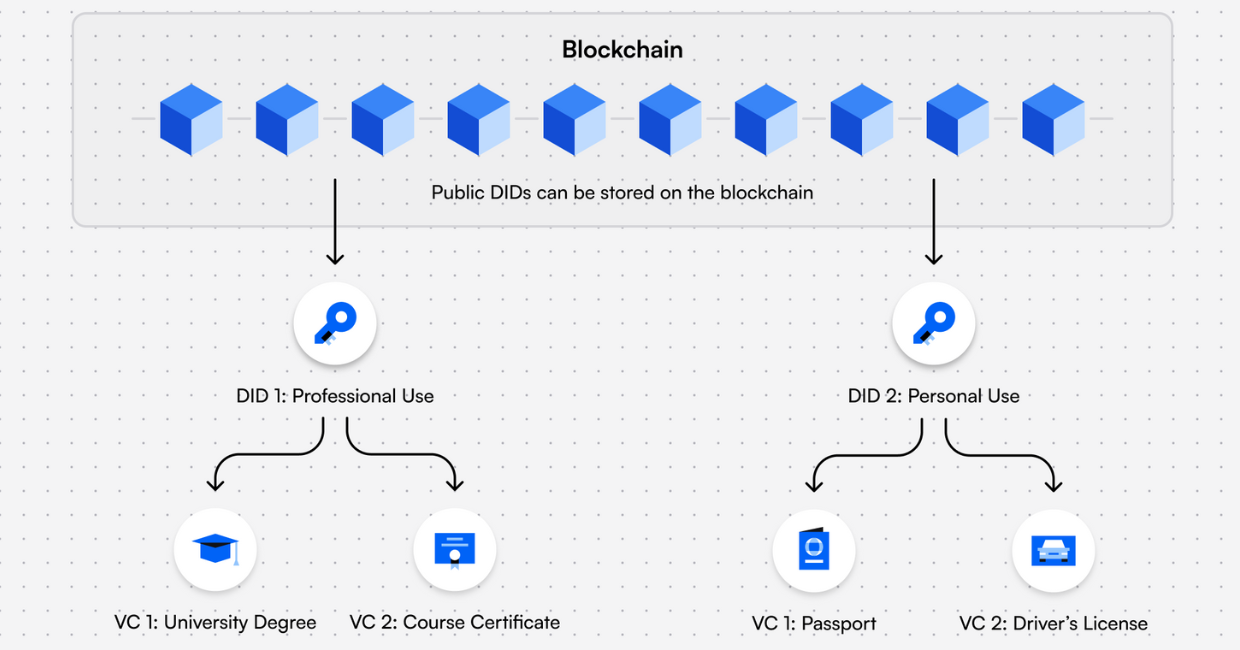
Verifiable Credentials linked with Decentralized Identifiers (DIDs): Illustrates how digital credentials (e.g., driver’s license) are issued, stored, and verified using blockchain-based identity management. (Source: Dock.io)
- Trust through Cryptography: Blockchain identity systems leverage public–private key cryptography. Instead of sharing passwords, users authenticate by proving possession of private keys (through digital signatures). This approach ensures irrefutable authentication only the holder of the private key (the legitimate user) could have signed a transaction or request. It’s far more secure than password-based logins and resists phishing or replay attacks.
- Auditability and Compliance: Every identity verification or credential issuance recorded on the blockchain is traceable. Businesses can easily audit compliance with KYC/AML regulations, and share verified KYC data with each other (with user consent) to avoid redundant checks. This streamlines onboarding while maintaining high assurance.
By embedding data integrity at the core, blockchain transforms digital identity from a fragile, siloed model into a secure, user-centric model. However, ensuring someone is who they claim to be in real-time still requires intelligence at the edges – which is where AI comes in.
AI: Enhancing Identity Verification and Anti-Deepfake Defense
Artificial Intelligence brings powerful tools to verify identity and detect fraud in ways that static rules or human inspection cannot. Modern AI algorithms can analyze biometrics and behavior with high speed and precision, providing dynamic defenses against impersonation and deepfakes:
- Biometric Verification: AI powers advanced facial recognition, fingerprint and iris scanning, and voice recognition systems to confirm a person’s identity. These systems check that a user’s live selfie matches the photo on their ID, or that a voice sample matches the known profile. AI improves accuracy in matching, even accounting for changes in appearance or environment. It also enables continuous authentication (e.g. analyzing typing patterns or facial features during a session) for added security.
- Liveness Detection: To combat spoofing and deepfake attempts, AI-driven liveness detection prompts users to perform certain actions (blink, smile, turn head) or analyses texture and motion to ensure there’s a real live person present. This helps flag videos or images that are replays or AI-generated, not genuine live capture. Cutting-edge liveness algorithms can detect subtle artifacts of deepfakes – irregular eye movements, skin texture inconsistencies, or lip-sync mismatches – as signs of fraud.
- Deepfake Detection (Anti-Deepfake): Beyond liveness checks, specialized AI models are trained to recognize deepfakes by analyzing digital content frame by frame (or audio sample by sample). They look for telltale signs of manipulation (e.g. abnormal blinks, glitches in shadows, audio distortion) that human eyes/ears might miss. Anti-deepfake AI can scan user-submitted videos or documents in onboarding to block synthetic identities before they wreak havoc. For example, AI can verify if an ID document is real or an AI-generated replica, and if a selfie video is genuine or a sophisticated morph.
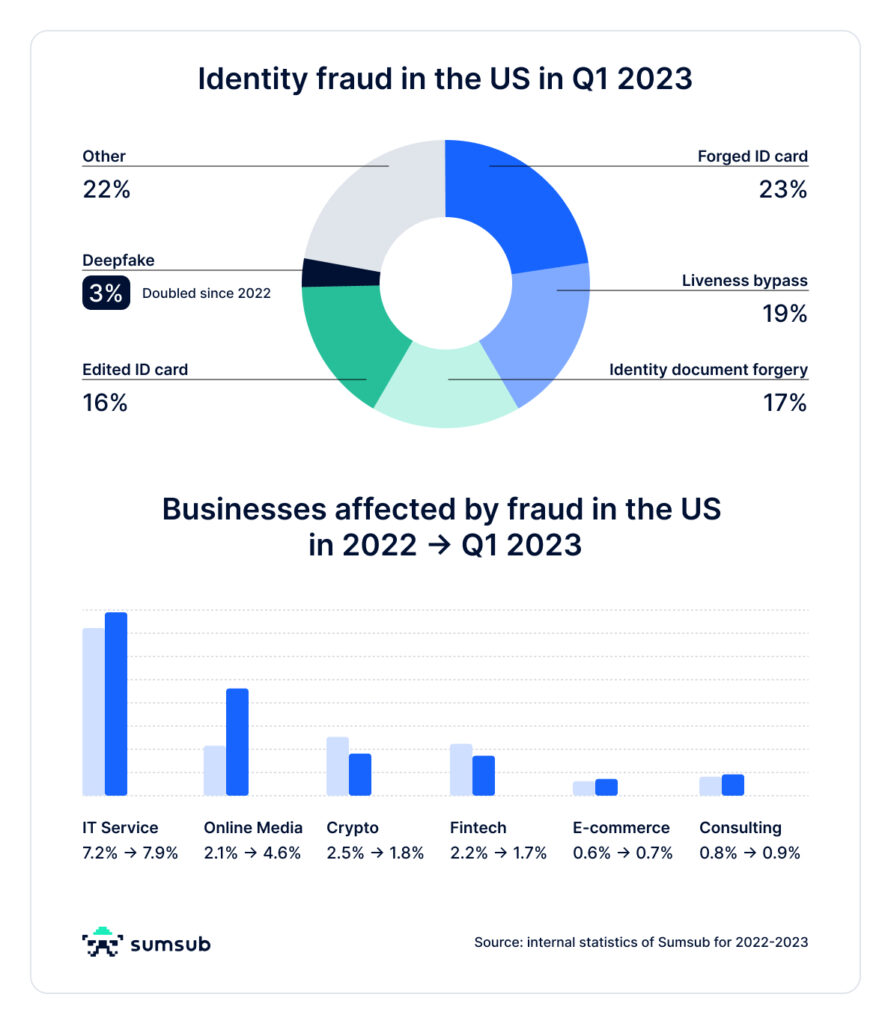
Infographic of fraud types intercepted by AI in North America. Highlights how deepfakes, liveness bypass, and document forgery are measured, demonstrating how AI serves as a frontline defense against synthetic identity threats. (Source: Sumsub)
- Behavioral Analytics: AI also monitors user behavior patterns (login locations, device usage, transaction habits) to spot anomalies that could indicate identity theft or account takeover. If a normally inactive account suddenly attempts high-value actions, or if a user’s typing cadence drastically changes, AI-driven fraud systems raise flags. These adaptive risk engines catch identity fraud that slips past initial verification.
- Improving User Experience: Importantly, AI can strengthen security without adding friction for legitimate users. Machine learning tailors identity verification steps to risk level for low-risk scenarios, it might streamline pass-through, while high-risk actions trigger extra biometric checks. AI can even assess document quality and provide real-time feedback during onboarding (e.g. “ID photo is blurry, please retake”), making the process smoother. The result is robust security with minimal inconvenience, a key factor for user and business adoption.
AI’s capabilities are continually evolving, because it learns from new fraud patterns. However, AI alone isn’t foolproof – deepfake generators also improve, and AI models can be fooled or biased. This is why combining AI with the ground truth assurance of blockchain is the ultimate recipe for trustworthy digital identity.
Blockchain + AI = Trustworthy Digital Identity Systems
By merging blockchain and AI, organizations can build multi-layered digital identity systems far more resilient than either technology alone. Blockchain provides the secure infrastructure and single source of truth for identity data, while AI provides the smart analytics and real-time verification at the entry and usage points. Key benefits of this synergy include:
- End-to-End Authenticity: Blockchain guarantees the integrity of stored identity data and credentials (they are issued by trusted parties and protected against tampering), whereas AI validates that the live user or content presented now is authentic. Together, they ensure that both the background data and the real-time input are trustworthy. For example, before a user is granted access, the system confirms their blockchain-registered credential is valid and AI confirms their face or voice matches that credential and is not a deepfake.
- Real-Time Verification on a Tamper-Proof Ledger: AI can instantly cross-check a user’s presented ID or biometric data against blockchain records. If someone tries to use a forged document or a stolen digital ID token, it won’t match the cryptographic record on the ledger and access is denied. Every verification event can be logged on-chain as well, creating an audit trail that can’t be altered – useful for compliance and forensic analysis.
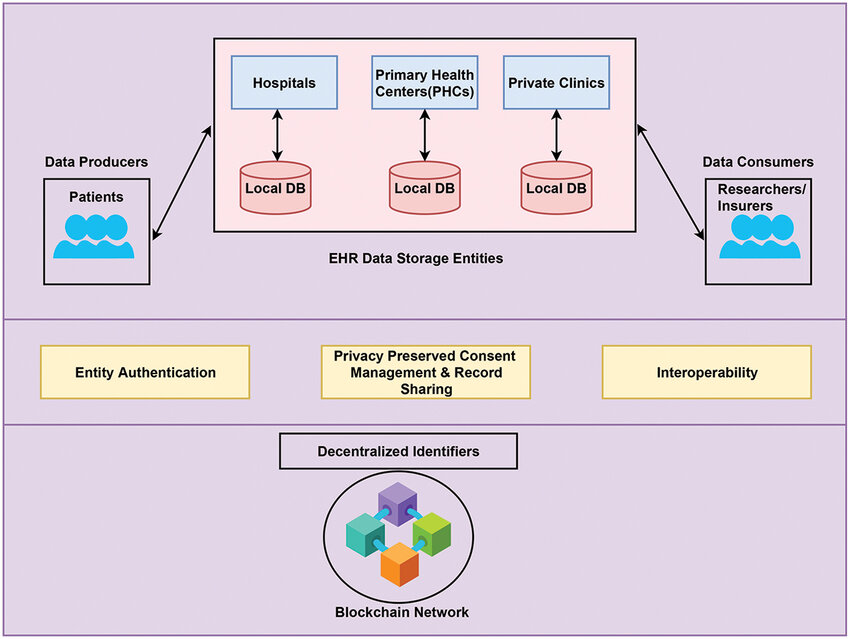
Architecture for blockchain-based decentralized identifiers, illustrating how identities are anchored in a blockchain system, which can be extended with AI modules for validation. (Source: Taleka et al., Cogent Engineering (2022))
- Multi-Factor, Multi-Layer Security: A combination of something you have (a blockchain-registered credential or private key), something you are (biometric face/fingerprint confirmed by AI), and something you do (behavioral patterns analyzed by AI) can authenticate a person with high certainty. Even if deepfakes can trick one layer, the other layers provide fail-safes. Industry experts emphasize that such a multiple detection approach blending AI-driven biometrics with robust identity verification – is crucial to defend against AI-powered fraud.
- User Empowerment & Privacy: In a blockchain + AI identity framework, users can control their own identity data via private keys (enabling SSI). They only share minimal necessary information, and blockchain’s cryptography can even enable zero-knowledge proofs (verifying a claim without revealing the data itself). AI assists users in managing consents and detecting misuse of their identity. This means higher privacy and convenience compared to handing all personal data to third parties for verification.
- Scalability and Interoperability: Blockchain-based identities (often using standards like decentralized identifiers (DIDs) and verifiable credentials) are globally portable – a user could use the same digital identity to open a bank account, verify age for an e-commerce delivery, or log into an office building. Blockchain provides the common trust layer across organizational boundaries. AI adds to this by seamlessly integrating identity verification across different platforms and automating decision-making. The result is a universal digital identity that is accepted widely, with AI ensuring security in each context.
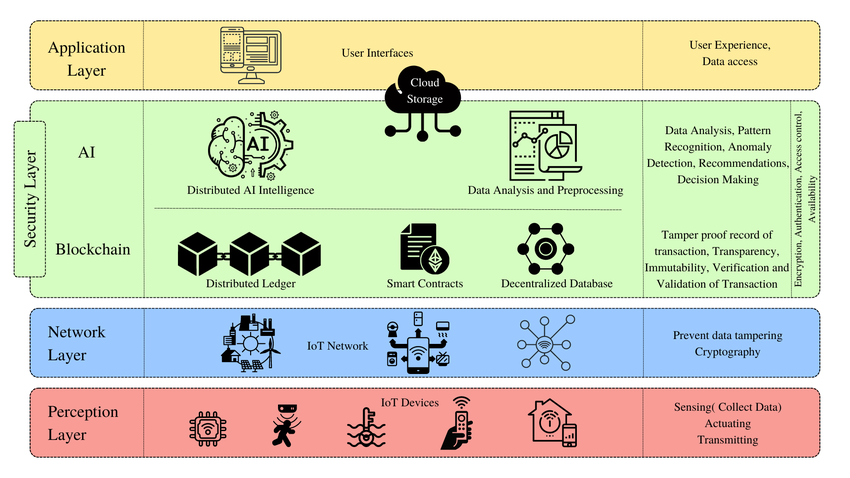
Architectural framework integrating blockchain and AI, illustrating layered system design, which can be adapted to identity systems where AI handles verification and blockchain ensures data integrity. (Source: Nalband et al., Blockchain–AI IoT security architecture (2023))
In practice, this powerful combo is already taking shape. For instance, verifiable credentials (VCs) anchored on blockchain (digital proofs of ID or qualifications) can be presented to any verifier; AI checks the presenter’s biometrics and the VC’s validity, confirming both the person and the credential are legitimate.
If a deepfake or impostor tries to use someone else’s credential, the AI will catch the mismatch. On the other hand, if someone tries to present correct biometrics but a fake credential, the blockchain will reject it. Trust is verified at both levels – data integrity and live verification.
Use Cases and Industry Applications
A trusty digital identity system that leverages blockchain and AI has broad applications across industries where security and authenticity are paramount:
- Financial Services (KYC/AML): Banks and fintechs can streamline customer onboarding with AI-driven document verification and liveness checks, while issuing customers blockchain-based digital IDs or KYC tokens. This prevents fraud (like synthetic identities or deepfake video onboarding) and lets institutions reuse verified identities across partners. The result: faster compliance checks, reduced fraud losses, and a smoother customer experience in everything from opening accounts to executing high-value transactions.
- Government & Public Sector: Governments can issue digital national IDs or e-passports secured on a blockchain, giving citizens a self-sovereign identity to access services. At border control or online portals, AI-powered facial recognition validates the person against the ID, thwarting impostors who might use stolen documents or lookalikes. Blockchain ensures no one can fake or alter the ID records (for example, trying to create a false identity or tweak their age/status). This approach also enables secure digital voting and public benefit distribution by verifying each participant’s identity with high confidence.
- Healthcare: Patient identities and medical credentials can be managed on blockchain for privacy and integrity. A patient owns their health ID and records; hospitals and clinics verify identity via AI biometrics (face or fingerprint scan) before granting access to records or treatment. This prevents mix-ups and fraud (like insurance fraud via fake identities). In telemedicine, AI can confirm the patient’s identity (ensuring the right person is present on a video call) and even detect if any deepfake manipulation is happening in sensitive cases. Health data ownership remains with patients, who grant access via blockchain tokens.
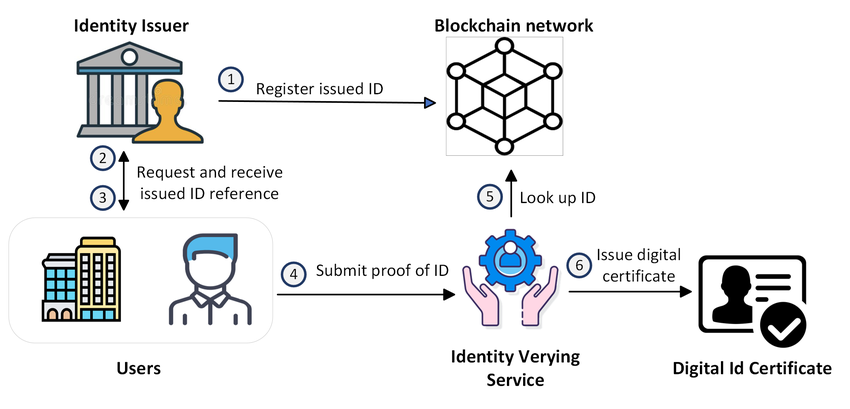
Digital Identity Authentication: the ID issuing authority registers and stores issued digital ID certificates on blockchain, enabling decentralized verification (Source: ResearchGate)
- Content and Media Authenticity: To combat misinformation and deepfake videos, media outlets and content creators can timestamp and sign content on a blockchain at creation. This establishes an authenticity ledger. Consumers or platforms can use AI to verify new content against these records – e.g. an AI system flags a video of a public figure as unverified if it doesn’t find a matching authenticity token, or if the facial movements don’t match known patterns. Social networks could similarly verify user profile pictures or videos through this combo (blockchain certificate of authenticity + AI image analysis), reducing the spread of fake media. Creators also get proof of ownership for their digital content, which can help with IP protection.
- Enterprise Security: Corporations can issue employees blockchain-based digital identity badges for system and building access. Instead of insecure RFID cards or passwords, an employee uses a cryptographic ID (stored in a mobile wallet) and passes an AI facial recognition gate. Only if the person’s face matches the ID and the ID is valid on the blockchain do they gain access. This nearly eliminates badge-sharing or tailgating risks. AI continuously monitors for anomalies (like someone trying to use an ID at an odd hour or location), while blockchain logs ensure any access grant is traceable and unalterable. This approach strengthens cybersecurity and physical security concurrently.
These examples only scratch the surface. Any domain that relies on trustworthy identity verification from education credentials to supply chain provenance can benefit from blockchain and AI working in tandem. The result is higher security, automated fraud detection, and greater user trust.
Conclusion
As deepfakes and data breaches threaten our digital world, the convergence of blockchain and AI offers a path to restore confidence. Blockchain AI digital identity solutions provide both the trust framework (through decentralized, tamper-proof data) and the intelligent guardrails (through AI verification and fraud analysis) needed to outsmart bad actors.
By embracing blockchain for data integrity and ownership proof, and AI for identity verification and anti-deepfake defense, organizations can build next-generation digital identity systems that are both user-friendly and highly secure. Now is the time to act.
Ready to enhance trust in your digital identity processes? Twendee – a leading provider of blockchain and AI solutions can help you design and implement trusty digital identity systems tailored to your needs. Our experts have deep experience in blockchain-based identity platforms and AI-driven verification. Contact Twendee today to discover how our blockchain + AI services can protect your business from deepfake fraud and identity threats, while unlocking seamless and secure experiences for your users. Let’s build a future of digital identities you can truly trust.
Connect with us on LinkedIn or X to explore how Twendee can support your transformation: Twitter & LinkedIn Page
Read latest blog: Restaking Platforms Are Emerging as the Primary Yield Source for Institutional DeFi





